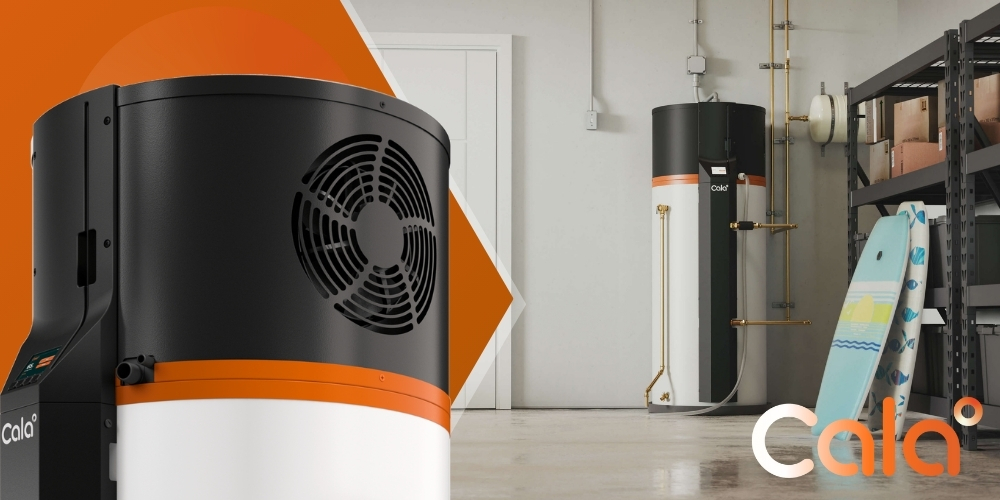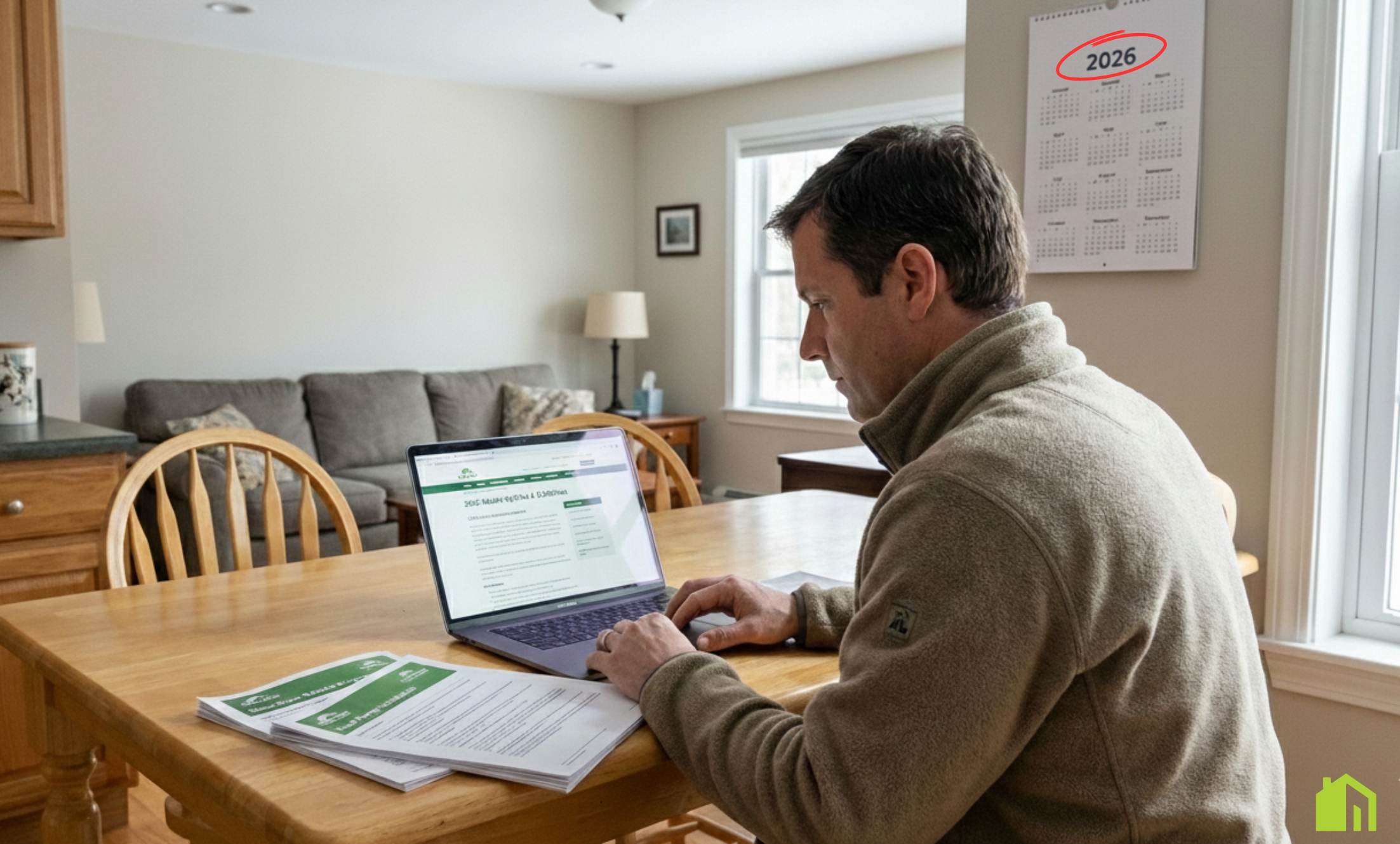CO Detector Installation and Massachusetts Code Compliance Explained

Intelligent Heat Pump Water Heaters for Massachusetts Residential Homes — Why SumZero Selects Cala
By SumZero Energy Systems — Massachusetts’ #1 Heat Pump Installation Team
Picking a new water heater once involved a simple decision between gas and standard old electric, praying the hot water wouldn't be gone when there were two showers in a row. That's no longer the case. Now, the ideal solution for the majority of Massachusetts homes is a smart heat pump water heater (HPWH). This isn't the typical hybrid of which you might have heard, but a rather new breed of unit that adapts to your home's schedule, accommodates your energy usage, and maintains comfort consistently while consuming a lot less energy.
When homeowners want to have it exactly right the first time, our team is discerning about what products we choose. We consider the landscape and inspect the details before determining that they might work with Cala, a company that produces a high-technology hot water heater that modern homes need: intelligent, consistent, and efficient hot water — installed properly. This article describes why this alliance matters, how the tech benefits your home, what you should expect from our installation, and the handy information (rebates, credits, fit questions) homeowners inquire about daily.
Why This Alliance Is Important
(and What It Does for You)
There are two parts to a successful hot water solution:
Great technology
A system that makes you comfortable and uses less energy.
Great installation
Design, placement, airflow, electrical, condensate handling, commissioning, and long-term support.
Cala provides a tailor-built, smart HPWH platform. SumZero provides actual-world experience so that it works perfectly in real Massachusetts homes.
Together, we provide three things homeowners report wanting:
Accurate hot water at peak periods without guessing.
Cheaper monthly energy bills without compromise on comfort.
It is a future-proof solution that addresses the trend towards greener, all-electric homes.
Simply put: We get hot water. We know how to properly install heat pump technology. This combination makes a water heater upgrade a smart, long-term decision.
The Homeowner's Dilemma That We Are
If you have had a gas or a typical electric water heater, then you know the problems:
Hot-cold swings on hectic morning routines.
Higher electricity bills than hoped for.
No real insight, no real control.
A replace cycle that is experienced as "buying the same thing again."
Typical hybrid: Heat pump water heaters perform better, yet they still react: They delay until the tank cools off, then warm it up again. Homeowners averred they desire a system which thinks ahead—a unit which is a breeze to operate, handles peak load graciously, and does not make them compromise.
They fill that gap, which is why we work with them.

Why a Smart HPWH is Different
A standard electric water heater makes heat by passing an electric element, a giant toaster coil, through the tank. A heat pump water heater does it another way: it takes heat from the air it lives in and puts it into the water. Because it costs less energy to move heat than create it, heat pump water heaters run on much less power than typical electric ones. And they avoid burning gas, venting, and pollution.
A smart HPWH goes one step further:
It adapts to your home's schedule (morning showers, nighttime laundry) and preheats when demand isn't yet high.
You can use the app to check, plan, or increase hot water whenever you want.
It has a compressor that can change speed to fit what you need (not just "on/off").
It is achievable with a mixing valve holding water at the proper warmth for improved efficiency and then providing a sustained, safe warmth for usage. This is also possible with the availability of additional warm water at peak usage times.
It goes nicely with a contemporary home — primed for solar, time-of-use, and information you can view at a glance.
Result: more stable comfort, less energy use, improved control.
Why a Smart HPWH is Different
From what is visible on-site, there are three things certain for homeowners regarding the points of Cala:
1) Ease That Is Effortless
Consistent hot water at peak use is the ultimate test. Through forecasting demand and using a mixing valve, Cala maintains a steady supply. That results in less "uh oh" when two showers coincidentally happen at once or someone turns on the dishwasher.
2) Controls That You'll Ever Use
App functionality is key when done properly. You can check if there's hot water, turn up the heat for guests, view energy usage history, or simply set it and leave. As installers, we appreciate performance data — it allows us to address little issues before large ones form.
3) Future-Ready from Day One
Massachusetts is going towards clean, electricity-based homes. Cala's strategy combines well: it is scalable for solar power and accounts for time-of-use rates when needed. If you foresee solar energy at some time, or already have it, this water heater won't stop your home from being efficient.
4) A Company That Stands Behind Its Product
Cala backs every unit with a 10-year parts warranty and 3-year labor warranty — a strong sign they stand behind both the technology and the people who install it. At SumZero, we respect that kind of commitment because it mirrors our own approach: taking care of homeowners and supporting our partners with the same level of trust and accountability.
What SumZero Offers As Your Installer
(Why It Matters)
Even the best system won't work so great if installed wrong. Our task is getting your new HPWH working perfectly inside your home, not on a drawing board. This is what our approach is:
Right-size design.
We measure how much water your home needs and discuss the high-flow fixtures, filling bathtubs, and washer usage.
Best installation and ventilation.
HPWHs require air to make the heat move. We consider the room size, doors, vents, and — when necessary — ducting solutions for high performance and low noise.
Clean handling of electricity and condensate.
Safe power, tidy routing, and a trustworthy drainage plan are essential.
Commissioning correctly.
We don't just "turn it on." We verify performance, position the mixing valve, help you with the app, and verify your comfort objectives.
Rebates, credits, and financial assistance.
Mass Save, federal 25C, and the 0% HEAT Loan (if applicable) — we'll help you with that.
We take special care.
Our teams respect your home, protect your floors, and leave the place nicer than they found it.
Aftercare you can count on. Questions years down the road? We're here. The whole concept of a smart system is long-term confidence, not a one-day installation.
Costs, Incentives, and Lifetime Value
Two parts matter here: upfront cost and operating cost.
→ It is a better unit than a standard electric or simple hybrid. Tax credits and rebates make a big difference. A lot of Massachusetts homeowners rely on the 0% HEAT Loan for easier payments.
→ Month after month, the intelligent HPWH's effectiveness is where the value lies. By transferring (not creating) heat and by scheduling heating intelligently, homeowners consistently experience significant decreases in water-heating energy consumption — particularly relative to resistance electric, and many times relative to gas or delivered fuels when full costs are factors.
If you'd like figures specific to your home (household number, showering usage, energy costs), we'll do the math at your consult and provide you with a clear estimate of payback, lifetime cost saving, and the rebates for which you qualify.
Are Smarter Heat Pump Water Heaters Good for Your Home?
It is feasible for many Massachusetts homes. We will cover:
→ Household size and routines. Families with up to about 5 people usually do well with the standard setup; we will give advice for larger families or special situations.
→ Space and ventilation. We check the space, door vents, or ducts if necessary, and ventilation so the system operates properly.
→ Location. Basements are typical, as are utility rooms. As the unit functions, it removes air that feels like a dehumidifier — a typical plus for basements.
→ Electrical. We check panel capacity and proper wiring; no installation day surprises.
→ Future plans. Now or in the future for solar? Time-of-use rates? We'll put the system on so it grows with your home.
[[cta-heatpump]]
Why Is Cala Different from "Traditional Hybrids"?
✪ Control and Convenience:
Cala integrates intelligent tech with a mixing valve to remain comfortable, even when it is busy. Most standard hybrid units have simple modes and react only when the tank becomes chilled.
✪ Care and Trust:
Performance insights help you recognize problems early on and keep you on your feet for surprises. Traditional deployments are mostly "wait and see."
✪ Timing and Efficiency:
Variable driving and improved scheduling assist in energy saving with the maintenance of comfort. Ordinary hybrids operate more often and at undesirable times.
✪ Future-Ready
The design of the Cala accommodates with solar power, intelligent homes, and plans for utilizing electricity. Most older hybrids were not built for that usage.

What to Expect with SumZero
(From the First Call Through the First Shower)
✪ Talk & Pictures
We'll first glance at your objectives and take some fast photos of the current installation: the water heating unit, panel, and surrounding room.
✪ Right-Fit Design
We fit your hot water consumption and available spaces to a design which we endorse.
✪ Chaplain: A Comprehensive
Your quote is going to be transparent, includes information for installation, accessories, and a checklist for incentives. The paperwork assistance takes care of our end.
✪ Professional Installation
Licensed, insured, and detail-orientated. We dispose of the old unit, prepare the site, install and commission a new system, and leave the site tidy.
✪ App Introduction and Instructions
You'll discover how to see hot water supply, schedule increases, and view consumption — without being "technical."
✪ Support and Help
We're your long-term partner. Got a question? You call us — that's what homeowners deserve from the #1 heat pump installation company.
Common Questions We Get
(And Easy Answers)
Smart heat pump water heaters move heat from the surrounding air into the water instead of generating heat directly. This makes them up to three to four times more efficient than standard electric models. Cala’s intelligent system takes it further — it learns your household’s patterns, preheats before busy periods, and gives you app-based control to monitor or boost hot water anytime.
Most hybrid water heaters react when the tank cools. Cala predicts when your home will need hot water and heats proactively, saving more energy while maintaining comfort. It also features a variable-speed compressor, integrated mixing valve, and performance monitoring portal, giving both homeowners and installers a smarter, more reliable experience.
Savings depend on your energy source and usage, but many Massachusetts homeowners cut their water-heating costs by 50–70% when switching to a heat pump system. Cala’s intelligent controls add even greater efficiency. Add Mass Save® rebates, federal 25C tax credits, and potential 0% HEAT Loan financing, and most families see real payback within just a few years.
Yes — most Massachusetts homes are a great fit. Cala’s 65-gallon design comfortably serves households up to five people and can prepare up to 90 gallons ahead of peak use. The system needs adequate space and airflow, similar to a dehumidifier, and our team at SumZero handles every detail — from placement and ducting to electrical and performance checks.
SumZero Energy Systems is Massachusetts’ #1 heat pump installation team, trusted for precision, transparency, and high-quality service. We manage every step — design, installation, rebate paperwork, app setup, and long-term maintenance — so homeowners enjoy smarter comfort and lasting confidence. With SumZero, you’re not just buying equipment; you’re gaining a partner who stands behind it.
Why We Feel Secure Recommending This to Massachusetts Homeowners
We have a simple promise: we only install solutions that we would use in our own homes. Cala’s approach — being smart, having control, and being ready for the future — matches what we have learned from many talks with homeowners in the state. Together with SumZero’s careful installation standards and ongoing support, this water-heating upgrade makes sense right away and will last well with your home. Cleaner heat. Smarter comfort. Fewer bills.
Ready to Take the Next Step?

To learn more about Cala’s technology and vision, visit Cala Systems.
Understanding Massachusetts Requirements for Carbon Monoxide Detector Installation
If you're a Massachusetts homeowner, staying up-to-date on home safety rules isn't just about peace of mind — it's required by law. Carbon monoxide detector installation is one of the most important areas of code compliance in the state, and it’s vital for protecting your family from a silent, odorless threat that affects hundreds of homes each year. Massachusetts has some of the most comprehensive CO detector laws in the country, and knowing what’s required can help prevent costly mistakes — and potentially save lives.
What the Massachusetts CO Detector Law Requires
Massachusetts law mandates carbon monoxide detectors in all residential properties that use fossil fuels (like gas or oil) or have garages. The law is also strict about where and how these detectors must be placed.
Here’s a quick overview of the key placement rules:
- One CO detector on every habitable level of the home, including finished basements
- Detectors must be within 10 feet of each bedroom door
- Homes built after 2008 require hardwired or wireless interconnected detectors with battery backup
- If you have a garage under your home, a detector is required on the level above
Many homeowners don’t realize that Massachusetts law has stricter CO detection standards than most states, especially for multifamily homes and homes with attached garages.
Understanding these requirements ensures you're not only code-compliant but also giving your family the best protection against carbon monoxide risks.
Placement Mistakes Massachusetts Homeowners Commonly Make
Misunderstanding the law can lead to improper installation. Here are a few slip-ups we see often in homes across the state:
- Placing detectors too close to fuel-burning appliances
- Installing them too low on the wall instead of on the ceiling or upper wall
- Ignoring finished basements or attic living spaces
- Using outdated, expired devices
A good rule of thumb: keep detectors on each level, near sleeping areas, and away from vents or open windows.
Smart CO Detectors for Higher Safety
With the advancement of home tech, many homeowners in Massachusetts are now choosing smart carbon monoxide detectors. These devices offer benefits like:
- App notifications if dangerous levels of CO are detected
- Battery life alerts and real-time status updates
- Integration with smart thermostats and home automation systems
While standard detectors certainly do their job, smart models give an added layer of protection — especially for frequent travelers or families with young kids or elderly members.
A Massachusetts family using a smart CO detector was alerted via mobile notification while at work. Emergency responders later confirmed a leak that would've remained undetected for hours.
Smart detectors can be the difference between catching a slight problem early or facing a dangerous emergency. They’re especially worthwhile in larger homes or multifamily setups, where CO can go unnoticed in less-frequented areas.
[[cta-heatpump]]
When and Why to Replace Your Carbon Monoxide Detectors
Even if your detectors are properly installed, they don’t last forever. Replacing carbon monoxide detectors on time is just as crucial as getting them set up correctly in the first place. Over time, sensor accuracy diminishes, which means your device might not sound off when it should.
How Often Do You Need Carbon Monoxide Detector Replacement?
Massachusetts doesn’t just require CO detectors — the state also recommends regular replacement timelines to keep them reliably functioning.
Follow these general replacement guidelines:
- Battery-operated detectors: Replace every 5-7 years depending on manufacturer’s instruction
- Hardwired or plug-in models: Replace after 7-10 years
- Smart detectors: Follow the brand's end-of-life indicator or built-in alert system
Most detectors have a sticker or stamp underneath with the manufacturing date. If yours don’t, err on the side of caution and replace them.
Signs It’s Time for a CO Detector Replacement
Keep an eye out for these signs that your carbon monoxide detector isn’t doing its job:
- Frequent false alarms or beeping for no reason
- No response when tested
- Faded or unreadable labels
- Lack of a digital display on newer models
One study found that 30% of homes with detectors over 10 years old were not alerted during CO testing simulations, due to worn-out sensors.
Taking proactive steps like replacing outdated units helps you stay compliant and avoid relying on a false sense of security.
Choosing CO Detector Services That Keep You Compliant
Massachusetts doesn’t demand professional installers, but having someone who knows the code ensures nothing is overlooked. Whether you're updating old devices or installing for the first time, it’s essential to approach the job with a plan that keeps your home and family safe.
What a Thorough CO Detector Installation Should Cover
If you’re tackling this yourself or working with a service, make sure these points are addressed:
- A review of all fuel-burning appliances such as furnaces, water heaters, and fireplaces
- Identification of every floor that needs a detector
- Consideration for bedrooms and all sleep areas
- Interconnection strategy, especially for homes built after 2008
- A test after installation to check device function and signal strength (for wireless models)
Many homeowners find value in using this time to also test or replace their smoke detectors. Massachusetts law often requires smoke and carbon monoxide detection updates together, especially when selling or renovating a home.
Benefits of Upgrading to Interconnected Detectors
Modern codes encourage interconnected detectors — if one goes off, they all go off. This improves safety dramatically, especially in multi-level homes.
Massachusetts encourages the use of these interconnected systems, especially in homes constructed or renovated after 2008. Interconnected models are typically:
- Hardwired with a backup battery
- Wirelessly connected through radio signals or Wi-Fi
- Easier to test and maintain as a group
Once you’re connected, testing one detector runs a test on all, saving you time during routine safety checks.
According to Mass Save®, updating to current CO detection and interconnection standards can yield homeowner insurance discounts, while boosting real estate value at resale.
Interconnection not only keeps your home safer but also prepares you for home inspections that include CO and smoke detector checks.
Final Thoughts for Massachusetts Homeowners
Staying compliant with carbon monoxide detection laws in Massachusetts is more than just a checkbox — it’s a key investment in your family's safety and long-term home value. Regular installation checks, timely replacements, and smart upgrades help you stay ahead of potential hazards.
If it's been several years since you've touched your CO detectors, now is the time to review your system, test every device, and replace any units that are outdated or unreliable. A few moments of attention today can prevent major risks tomorrow.
For energy-efficiency tips or detector integration guidance, consider checking with Mass Save for additional resources and rebates that may fit your home's needs.
Ensure your home meets Massachusetts safety laws with expert carbon monoxide detector installation—protect your family from invisible dangers and gain peace of mind with smart, reliable solutions.
Install CO Detector NowYou Might Also Like…
Continue learning with handpicked articles that inform and inspire.
Not Sure Where to Start? We’ll Guide You
Let our experts design the right heating and cooling solution—customized for your comfort, your layout, and your energy goals. No pressure. Just clarity.
Request FREE ESTIMATE









